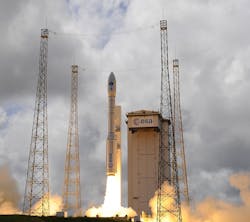What is the ESA's Vega launch vehicle?
The European Space Agency’s (ESA’s) Vega launch vehicle is designed to cope with a wide range of missions and payload configurations to respond to different market opportunities.
Payload masses range from 300 kilograms (kg) to 2500 kg, depending on the type and altitude of the orbit required by the customers. Vega is benchmarked to loft 1500 kg into a 700 kilometer (km)-altitude circular orbit at 90 degree inclination. It is the ideal launcher for most scientific and Earth observation missions.
Named after the second brightest star in the northern hemisphere, Vega makes access to space easier, quicker and cheaper. It operates from Europe’s Spaceport in Kourou, French Guiana.
Vega is a 3 meter (m)-diameter single-body vehicle, standing 30 m tall with a liftoff mass of 137 tonnes. It has three solid-propellant stages and a liquid-propellant upper module for attitude and orbit control, and satellite release.
Vega officially became an ESA program in June 1998, when the Agency inherited the small-launcher program of Italy’s ASI space agency.
Following Vega’s debut on 13 February 2012, ESA’s Verta (Vega Research and Technology Accompaniment) program was set up with the main objective of providing a framework for the smooth transition of Vega from development to exploitation. This included securing the initial exploitation of Vega by supporting the development of complementary technical advances and demonstrating a range of capabilities and flexibility over five more launches.
Vega moved to full commercial exploitation in December 2015.
At the same time, ESA refined and improved the launch system configuration and operations. This lowered costs mainly by speeding up the launch campaign.
The Vega launches in 2015 (IXV, Sentinel-2A and LISA Pathfinder) displayed the capacity of the system to reach three missions per year, providing confidence to customers and helping Arianespace to maintain its lead in this market segment.
ESA’s Launchers Exploitation Accompaniment Program, or LEAP, will ensure that Vega remains operational and that further improvements will reduce launch service costs.
At the ESA Ministerial meeting in December 2014, Member States agreed to begin developing the more powerful Vega C, now expected to debut mid-2019, with the main objectives:
- to strengthen Vega’s position in the market in the short to medium term;
- to increase launch vehicle performance by at least 300 kg and increase the flexibility for multiple payloads missions;
- to be able to introduce the Vega C configuration to the market from end-2018 at a cost no higher than today’s Vega, profiting from the shared development with Ariane 6 of the first-stage motor;
- to reduce the dependency on non-European sources in launcher production at no extra cost;
- to respond better to long-term institutional needs;
- to help maintain European industrial engineering capabilities, particularly in propulsion, in parallel to the Vega and Vega C exploitation.
Additional improvements are being studied to enable Vega to carry micro- and nanosatellites in order to be cost-effective in this emerging market.
European Launch Vehicle (ELV) SpA in Italy is prime contractor on the Vega C program. Company officials selected radiation-tolerant, commercial off-the-shelf telemetry system, including data acquisition, data handling, and RF transmission capabilities. Read more here.
Search the Aerospace & Defense Buyer's Guide
The go-to resource for Intelligent Aerospace technology news & information:
Covering key topics
Across all market segments
Subscribe to the free Intelligent Inbox e-newsletter
Subscribe to receive all the latest aerospace technology news & information, delivered directly to your e-mail inbox twice a week (Tuesdays and Thursdays). Sign upfor your free subscription to the Intelligent Inbox e-newsletter at http://www.intelligent-aerospace.com/subscribe.html.
Connect on social media
Keep pace with aerospace innovation and opportunities via your favorite social media channels. Connect with Intelligent Aerospace on Twitter (@IntelligentAero), LinkedIn,Google+, and Instagram.



